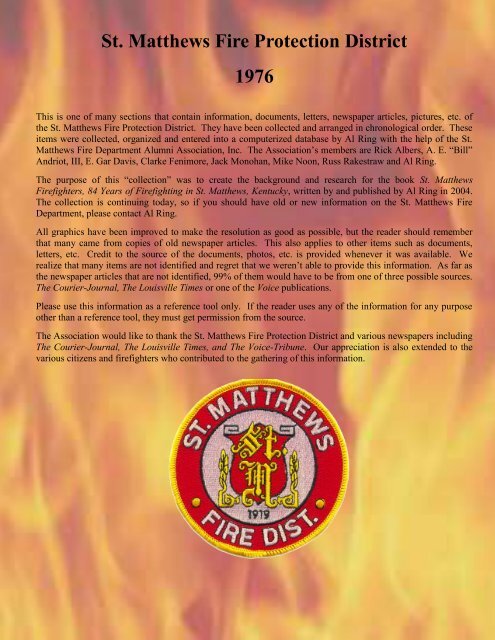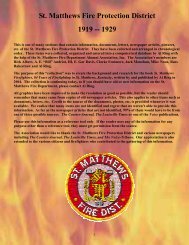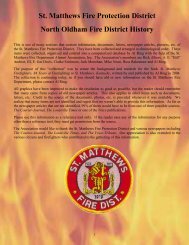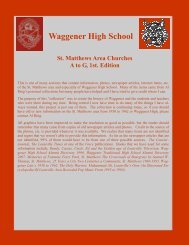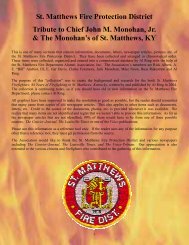St. Matthews Fire Protection District 1976 - RingBrothersHistory.com
St. Matthews Fire Protection District 1976 - RingBrothersHistory.com
St. Matthews Fire Protection District 1976 - RingBrothersHistory.com
Create successful ePaper yourself
Turn your PDF publications into a flip-book with our unique Google optimized e-Paper software.
<strong>St</strong>. <strong>Matthews</strong> <strong>Fire</strong> <strong>Protection</strong> <strong>District</strong><br />
<strong>1976</strong><br />
This is one of many sections that contain information, documents, letters, newspaper articles, pictures, etc. of<br />
the <strong>St</strong>. <strong>Matthews</strong> <strong>Fire</strong> <strong>Protection</strong> <strong>District</strong>. They have been collected and arranged in chronological order. These<br />
items were collected, organized and entered into a <strong>com</strong>puterized database by Al Ring with the help of the <strong>St</strong>.<br />
<strong>Matthews</strong> <strong>Fire</strong> Department Alumni Association, Inc. The Association’s members are Rick Albers, A. E. “Bill”<br />
Andriot, III, E. Gar Davis, Clarke Fenimore, Jack Monohan, Mike Noon, Russ Rakestraw and Al Ring.<br />
The purpose of this “collection” was to create the background and research for the book <strong>St</strong>. <strong>Matthews</strong><br />
<strong>Fire</strong>fighters, 84 Years of <strong>Fire</strong>fighting in <strong>St</strong>. <strong>Matthews</strong>, Kentucky, written by and published by Al Ring in 2004.<br />
The collection is continuing today, so if you should have old or new information on the <strong>St</strong>. <strong>Matthews</strong> <strong>Fire</strong><br />
Department, please contact Al Ring.<br />
All graphics have been improved to make the resolution as good as possible, but the reader should remember<br />
that many came from copies of old newspaper articles. This also applies to other items such as documents,<br />
letters, etc. Credit to the source of the documents, photos, etc. is provided whenever it was available. We<br />
realize that many items are not identified and regret that we weren’t able to provide this information. As far as<br />
the newspaper articles that are not identified, 99% of them would have to be from one of three possible sources.<br />
The Courier-Journal, The Louisville Times or one of the Voice publications.<br />
Please use this information as a reference tool only. If the reader uses any of the information for any purpose<br />
other than a reference tool, they must get permission from the source.<br />
The Association would like to thank the <strong>St</strong>. <strong>Matthews</strong> <strong>Fire</strong> <strong>Protection</strong> <strong>District</strong> and various newspapers including<br />
The Courier-Journal, The Louisville Times, and The Voice-Tribune. Our appreciation is also extended to the<br />
various citizens and firefighters who contributed to the gathering of this information.<br />
1<br />
Section 4<br />
1
<strong>1976</strong><br />
January <strong>1976</strong>: The department started a gasoline payback program for the firefighters.<br />
January <strong>1976</strong>: Pat Rhodes resigns from the department. He was later charged with arson and pleaded guilty to<br />
setting a string of fires in garages and a local car dealership last year.<br />
January <strong>1976</strong>: Membership <strong>com</strong>mittee: Frank Florence, Jack Monohan, Marty Kamer.<br />
January <strong>1976</strong>: <strong>Fire</strong>fighter’s Committee: Bill Andriot, Dave Kamer, Tim Golden, Rick Albers.<br />
January 13, <strong>1976</strong>: Former Captain Bill Dieckman rejoins the department. (Bill later moved on to be<strong>com</strong>e <strong>Fire</strong><br />
Chief in Shelbyville, Kentucky and then to the Chief’s position in Fort Thomas, Kentucky, until his retirement.)<br />
January 8, <strong>1976</strong>, The Voice:<br />
Unknown.<br />
2<br />
Section 4<br />
2
<strong>1976</strong><br />
January 8, <strong>1976</strong>, The Voice:<br />
January 8, <strong>1976</strong>, Board meeting:<br />
January 15, <strong>1976</strong>, The Voice:<br />
3<br />
Section 4<br />
3
<strong>1976</strong><br />
January 15, <strong>1976</strong>, The Voice:<br />
4<br />
Section 4<br />
4
<strong>1976</strong><br />
January 20, <strong>1976</strong>, Working fire 4008 Druid Hills Road.<br />
5<br />
Section 4<br />
5
<strong>1976</strong><br />
January 22, <strong>1976</strong>, The Voice:<br />
Former STMFD member.<br />
January 29, <strong>1976</strong>, The Voice: I show this so you can see how Shelbyville Road looked at this time.<br />
6<br />
Section 4<br />
6
<strong>1976</strong><br />
January 26, <strong>1976</strong>, Working fire at Jim Booher Body Shop, 282 N. Hubbards Lane.<br />
Red circle shows where building would be located. Below picture<br />
of building today (2010)<br />
7<br />
Section 4<br />
7
<strong>1976</strong><br />
January 26, <strong>1976</strong>, Working fire at Jim Booher Body Shop, 282 N. Hubbards Lane.<br />
January 27, <strong>1976</strong>: <strong>Fire</strong>men stop a train:<br />
January 26, <strong>1976</strong>:<br />
Comments by Al Ring: I was officer of S5 and in charge of the<br />
fire, DeHart was engineer of S5. Eventually S6, S3 and S1 made<br />
the run. Heavy smoke was <strong>com</strong>ing from everywhere when we<br />
pulled up. There was a huge garage door right in front with and office<br />
to the right. I know I talked with personal at the garage door<br />
and assume they told me where and what they thought the fire was.<br />
I ordered a 1 1/2 inch line through the front. We could not see what<br />
was burning but the smoke was jet black and very heavy. We were<br />
to advance through the front door. I also ordered window and back<br />
door ventilation. Without my knowledge DeHart put the ladder<br />
pipe up and got it ready for and aerial attack. Quickly advancing in<br />
the front we determined it was a car on a hoist in the air <strong>com</strong>pletely<br />
involved along with its tires causing the main smoke. Additions<br />
cars near it also were involved. The 1 1/2 inch line quickly handled<br />
it.<br />
8<br />
Section 4<br />
8
<strong>1976</strong><br />
January 26, <strong>1976</strong>: Great train race—<strong>Fire</strong>men worried about hoses on the track: For a few minutes it was vintage<br />
melodrama. <strong>Fire</strong>men battling the blaze at the Jim<br />
Booher Body Shop. Two hoses stretched across the railroad<br />
tracks. Train on its way.<br />
City-County <strong>Fire</strong> Alarm Office trying frantically to reach<br />
the Louisville & Nashville dispatcher to stop the train, before<br />
it literally cut the <strong>St</strong>. <strong>Matthews</strong> Volunteer <strong>Fire</strong> Department’s<br />
water off.<br />
‘‘P e r i l s of Pauline” scriptwriters couldn’t have improved<br />
on it. Including the happy ending. The train stopped<br />
in time. Damage at the body shop was relatively light.<br />
According to Capt. Al Ring, the <strong>St</strong>. <strong>Matthews</strong> department<br />
got the call about 2 p.m. yesterday, shortly after the fire<br />
began in an auto being serviced on a hydraulic lift.<br />
Four units with a total of 30 members were dispatched to<br />
the shop at 211 Hubbards Lane, and the blaze was brought<br />
under control in about 20 minutes. The auto on the lift was<br />
destroyed, and an auto on each side of it was damaged.<br />
Ring said there also was some damage to the roof, and<br />
some windows were broken, but the main structure was<br />
saved. “There was a lot more smoke than fire, he added,<br />
most of which came from burn-ing tires.<br />
Meanwhile, back at the fire alarm office in City Hall Annex,<br />
Sgt. George Hertel was on the switchboard when <strong>St</strong>.<br />
<strong>Matthews</strong> firemen informed him of their predicament: One<br />
of three hydrants being used was across the tracks from the<br />
body shop, which necessitated laying two 2 1/2 inch hoses<br />
across the L & N line.<br />
“It was a little hairy there for a while,” Hertel recalled. He<br />
first tried the number, he is supposed to use to reach L & N<br />
in an emergency. The line was busy, so he asked for a supervising<br />
operator. He told the supervisor to interrupt the<br />
busy line on an emergency basis. She tried, but, Hertel<br />
said, “We were told the lines to L & N were out of service.”<br />
Hertel said the operator then mentioned something about<br />
getting the police to help, and he decided to ask the police<br />
dispatcher to send a unit to L & N’s downtown headquarters<br />
building with a message to stop the train.<br />
Meanwhile, according to Capt. Sylvester Guzman, others<br />
in the alarm center “were frantically looking for a phone<br />
number that worked, and they finally found one.”<br />
Hertel heard, on a radio in the center, an exchange between<br />
two <strong>St</strong>. <strong>Matthews</strong> firemen in which one said to the other,<br />
“We may have to cut the lines to this (fire) <strong>com</strong>pany . . .<br />
there’s a train in the vicinity.”<br />
Finally the alarm center’s superintendent of <strong>com</strong>munications<br />
William Vollmer, decided to look in the white pages of the phone book. The number listed there for the general public to use<br />
worked, and the dispatcher was given the message to stop the train.<br />
Neither the officers in the alarm center nor the <strong>St</strong>. <strong>Matthews</strong> fire department spokesmen knew how close the train actually came. Or<br />
whether the police ever got to the L & N building.<br />
9<br />
But, after a moment of calculating, Hertel said the scene in the alarm center took “about five minutes.” It just seemed longer.<br />
Section 4<br />
9
<strong>1976</strong><br />
January 27, <strong>1976</strong>: <strong>Fire</strong>fighter Gary Butts and former Lieutenant Jim Jackson switch to inactive status.<br />
February <strong>1976</strong>: Joe Wheatley and Ran Florence are new applicants. Inactive member Jim Hytken rejoins.<br />
February 6, <strong>1976</strong>, Working fire 417 Kaelin Road.<br />
10<br />
Section 4<br />
10
<strong>1976</strong><br />
February 12, <strong>1976</strong>, Board meeting:<br />
February 12, <strong>1976</strong>, Letter:<br />
11<br />
Section 4<br />
11
<strong>1976</strong><br />
February 19, <strong>1976</strong>, The Voice:<br />
Change in Crusade Policy<br />
12<br />
Section 4<br />
12
<strong>1976</strong><br />
February 19, <strong>1976</strong>, Working fire at 673 Indian Hills Road.<br />
13<br />
Section 4<br />
13
<strong>1976</strong><br />
February 19, <strong>1976</strong>, Working fire at 673 Indian Hills Road.<br />
House <strong>Fire</strong> at #63 Indian Hills Trail, 2/19/<strong>1976</strong> at 9:05 AM (recalled by Rick Albers in October 2010)<br />
I remember this fire very well as I almost “bought it” at this fire! The run came in about 9AM and this address is all the way at the<br />
north end (bottom) of Indian Hills Trail, about ½ mile before you get to Rio Vista. I came in on 8836. We were second due. 8844<br />
was first out with Al Ring in charge and Jack Dehart driving.<br />
On this particular morning, Harrods Creek FD had just picked up engine 1227 from the shop where they had the gas engine replaced<br />
with a diesel. Kent Dayton and Jim Murphy were out on 1227 test driving it and were nearby when the fire was dispatched. So, they<br />
responded. The problem was that 1227, just <strong>com</strong>ing out of the shop, had no hose, no equipment, no air packs and no microphone on<br />
the radio; NOTHING but a booster line and a tank of water!!<br />
They pulled up first, just the two of them and their booster line on a fully involved 2-car garage attached to a 2-story house. This<br />
house is on the east side of the street and the garage is to the left as you face the front of the house. The garage doors open to the side<br />
and there are two windows in the garage facing the street. The driveway <strong>com</strong>es from the street towards the garage side and then<br />
makes a 90 degree right turn to the garage bays.<br />
There were two cars in the garage <strong>com</strong>pletely involved. <strong>Fire</strong> had already burned the roof off the garage and ran the breezeway into the<br />
attic and 2 nd floor of the house. They did what they could with the booster and tank water but to little avail. 8844 called on the scene<br />
with a working fire and called for help from Harrods Creek and Lyndon.<br />
When we pulled up in 8836, I saw 1227 in the driveway close to the garage, 8844 pulled in behind them and laid two 1-1/2” lines. I<br />
got off the pumper and got air packs off, then 36 laid a supply line to a hydrant. I remember seeing one of the 1-1/2” lines being<br />
aimed into the garage from its bays. This was pushing the fire into the house. The other line was being aimed into the breezeway<br />
window where 1227’s booster was originally. They were trying to cut off the fire from the house but it was too little too late. The<br />
opposing hose lines were aggravating the situation rather than helping it.<br />
Gerald Hardin (a Louisville firefighter who worked at Harrods Creek) and I were sent to the second floor to pull ceilings and find the<br />
fire so it could be cut off. By now, more people were on the scene and the roof was ordered opened up. We got upstairs and had no<br />
problem finding the fire. In fact, it came around behind us and cut us off from the stairs. Then the ceiling came in on us and there<br />
was fire everywhere. We managed to find the hallway at the top of the stairs and there was fire rolling across the ceiling and it was<br />
getting really hot. Gerald was in front of me and I recall at the end of the hall was a double hung window with the top half open. Gerald<br />
said to “get the f@%#% out now!” I wasn’t going to argue with someone with his experience. At that point he jumped up through<br />
the top of the open window and was gone! I looked at that and thought he had just jumped to the ground from the second floor. For a<br />
fleeting moment I thought that I didn’t want to <strong>com</strong>e slamming into the ground outside but then the room flashed over and that convinced<br />
me it would be in my best interest to follow Gerald’s lead.<br />
I wasn’t about to be able to make it out the upper half of that window so I closed the top and opened the bottom. To this day, I don’t<br />
know why I didn’t just take the damn thing out but I didn’t. I dove head first out the window, expecting to crash to the ground below<br />
but to my pleasant surprise, I was on a porch roof. Gerald was just getting up, his fire gear was steaming as was mine. We cursed a<br />
bit and then looked for a ladder to descend. We were on the roof in the rear and there was no ladder so we made our way around and<br />
up and over the peak of the main roof to find Kent Dayton and some others cutting several ventilation holes. <strong>Fire</strong> was exiting each of<br />
the holes and Gerald again said to get the f#@%# down off the roof, to everyone up there. They all followed suit which was a good<br />
thing. I remember getting down and going back to the front door where I followed a hose line till I saw flames again. About that time<br />
my low air bell was sounding and I was told to get out and get a fresh bottle.<br />
In the meantime, Jack Monohan had finally arrived on scene and took charge. He regrouped everyone and mounted another fire attack<br />
which this time was successful. The fire was finally extinguished but there was a lot of salvage and overhaul to do. After we had control,<br />
I was helping cover valuables on the first floor. There was a lot of water dripping down from above because they had used a lot<br />
on the 2 nd . Floor and in the attic. The place was a mess. We were there all day and back the next day for a minor rekindle. We made<br />
a third run there two days post fire, reported as a rekindle. I was the officer in charge on that one and it turned out to be dust stirred up<br />
in the attic area that reflected in sunlight <strong>com</strong>ing through one of the holes in the roof. False Alarm! Good thing!! We were still tired<br />
from a day earlier.<br />
14<br />
Section 4<br />
14
<strong>1976</strong><br />
February 19, <strong>1976</strong>, Working fire at 673 Indian Hills Road.<br />
15<br />
Section 4<br />
15
<strong>1976</strong><br />
March 2, <strong>1976</strong>: Tim Golden resigns as sergeant.<br />
March 4, <strong>1976</strong>, The Voice:<br />
16<br />
Section 4<br />
16
<strong>1976</strong><br />
March 11, <strong>1976</strong>, Board meeting:<br />
March, 1975, <strong>Fire</strong>men Magazine:<br />
17<br />
Section 4<br />
17
<strong>1976</strong><br />
March 16, <strong>1976</strong>, memorandum:<br />
18<br />
April <strong>1976</strong>: Rob Helm goes inactive. Jack O’Toole resigns as Sergeant, Dennis Bryant is promoted to Sergeant.<br />
New training program started with testing.<br />
Section 4<br />
18
April 8, <strong>1976</strong>, The Voice:<br />
<strong>1976</strong><br />
19<br />
Section 4<br />
19
<strong>1976</strong><br />
April 8, <strong>1976</strong>, memorandum:<br />
Editorial<br />
20<br />
Section 4<br />
20
<strong>1976</strong><br />
April 8, <strong>1976</strong>, Board meeting:<br />
April 15, <strong>1976</strong>, The Voice:<br />
21<br />
Section 4<br />
21
<strong>1976</strong><br />
April 22, <strong>1976</strong>, The Voice:<br />
STMFD almost always participated<br />
in these parades.<br />
22<br />
Section 4<br />
22
<strong>1976</strong><br />
April, <strong>1976</strong>, courtesy Mike Noland:<br />
<strong>Fire</strong>fighter Olympics, April <strong>1976</strong> <strong>Fire</strong>fighter Olympics, April <strong>1976</strong><br />
<strong>Fire</strong>fighter Olympics, April <strong>1976</strong><br />
Group shot at <strong>Fire</strong>fighters Olympics, April <strong>1976</strong><br />
Frank Florence, Brian Martin, Jim Hytken, Pat Noland,<br />
Charlie Davis, Dennis Bryant, Rick Albers, Bob Wheatley,<br />
Mike Noland, Joe Wheatley<br />
Group shot at <strong>Fire</strong>fighters Olympics, April <strong>1976</strong><br />
Bob Wheatley, Mike Noland, Brian Martin, Charlie Davis,<br />
Dennis Bryant<br />
Section 4<br />
23<br />
23<br />
Training <strong>Fire</strong>, April <strong>1976</strong><br />
Ken Reising, Jim Hytken, <strong>St</strong>uart Monohan??, Mike Noland,<br />
Sam McCune, Rick Albers, Charles McCune, Dwayne
<strong>1976</strong><br />
April, <strong>1976</strong>, courtesy Mike Noland:<br />
<strong>Fire</strong>fighter Olympics, April <strong>1976</strong><br />
<strong>Fire</strong>fighter Olympics, April <strong>1976</strong><br />
<strong>Fire</strong>fighter Olympics, April <strong>1976</strong><br />
Training <strong>Fire</strong>, April<br />
<strong>1976</strong><br />
Rick Albers, Mike<br />
Noland, Bernie Karem,<br />
<strong>St</strong>uart Monohan??,<br />
John Walling,<br />
Sam McCune, Charles<br />
McCune, ?????,<br />
Dwayne Reed<br />
24<br />
Section 4<br />
24
<strong>1976</strong><br />
April 29, <strong>1976</strong>, The Voice:<br />
May 6, <strong>1976</strong>, The Voice:<br />
25<br />
Section 4<br />
25
<strong>1976</strong><br />
May 13, <strong>1976</strong>, Board meeting:<br />
26<br />
Section 4<br />
26
<strong>1976</strong><br />
May, <strong>1976</strong>, Courtesy Mike Noland:<br />
Aerial Ladder, May <strong>1976</strong>, 8855<br />
May <strong>1976</strong>, 8855<br />
May <strong>1976</strong>, 8821<br />
27<br />
Section 4<br />
27
<strong>1976</strong> Crusade: $22,557.97<br />
<strong>1976</strong><br />
Newspapers $1,200.00, Westerman, $125.00, Mrs. Wrege, $2,000.00, Business, $1,250.00, Amvetts, $100.00, Canvas $13,466.62,<br />
Road blocks, $3.210.46<br />
8821, $1,213.37 8822, $933.74 8833, $3,071.92 8844, $3539.33 8855, $3,948.86 8836, $3.786.94<br />
28<br />
Section 4<br />
28
<strong>1976</strong><br />
<strong>1976</strong> Crusade: $22,557.97<br />
29<br />
Section 4<br />
29
<strong>1976</strong><br />
<strong>1976</strong> Crusade: $22,557.97<br />
30<br />
Section 4<br />
30
<strong>1976</strong><br />
May 27, <strong>1976</strong>, The Voice:<br />
Editorial<br />
31<br />
Section 4<br />
31
<strong>1976</strong><br />
May 13, <strong>1976</strong>, Board meeting:<br />
May 27, <strong>1976</strong>, The Voice:<br />
32<br />
June <strong>1976</strong>: Jack O’Toole and John Redman resign from the department. Jack moved to Oldham County and<br />
John was hired by the Louisville Division of <strong>Fire</strong> where he worked until retirement.<br />
Section 4<br />
32
<strong>1976</strong><br />
June 3, <strong>1976</strong>, The Voice:<br />
June 10, <strong>1976</strong>, The Voice:<br />
33<br />
Section 4<br />
33
<strong>1976</strong><br />
June 10, <strong>1976</strong>, The Voice:<br />
34<br />
Section 4<br />
34
<strong>1976</strong><br />
June 7, 1876, Louisville Division of <strong>Fire</strong> Multiple Alarm Book:<br />
35<br />
Section 4<br />
35
<strong>1976</strong><br />
June 10, <strong>1976</strong>, Board meeting:<br />
36<br />
Section 4<br />
36
<strong>1976</strong><br />
June 14, <strong>1976</strong>, Working fire at <strong>St</strong>. Francis Church, in Harrods Creek, STMFD assisted:<br />
June 17, <strong>1976</strong>, The Voice:<br />
37<br />
Section 4<br />
37
<strong>1976</strong><br />
June 17, <strong>1976</strong>, The Voice:<br />
July 1, <strong>1976</strong>, The Voice:<br />
July <strong>1976</strong>: Paul Dillman goes inactive, Joe Noland resigns as sergeant and Rob Helm rejoins.<br />
38<br />
Section 4<br />
38
<strong>1976</strong><br />
June 21, <strong>1976</strong>, Working fire 201 Breckenridge Lane, (2010) photo.<br />
39<br />
Section 4<br />
39
<strong>1976</strong><br />
June, <strong>1976</strong>, Courtesy Mike Noland:<br />
Softball, June <strong>1976</strong><br />
Skip Golden<br />
Softball, June <strong>1976</strong><br />
Jim Woodring<br />
Softball, June <strong>1976</strong><br />
Pat Noland<br />
Softball, June <strong>1976</strong><br />
Bill Andriot<br />
40<br />
Section 4<br />
40
<strong>1976</strong><br />
July 1, <strong>1976</strong>, The Voice:<br />
July 8, <strong>1976</strong>, The Voice:<br />
41<br />
Section 4<br />
41
<strong>1976</strong><br />
July 14, <strong>1976</strong>, Board meeting:<br />
Don Black leaves board.<br />
42<br />
Section 4<br />
42
<strong>1976</strong><br />
July 14, <strong>1976</strong>, Board meeting:<br />
Don Black leaves board.<br />
43<br />
Section 4<br />
43
<strong>1976</strong><br />
July 14, <strong>1976</strong>, Letter:<br />
44<br />
Section 4<br />
44
<strong>1976</strong><br />
July 15, <strong>1976</strong>, The Voice:<br />
45<br />
Section 4<br />
45
<strong>1976</strong><br />
July 22, <strong>1976</strong>, The Voice:<br />
46<br />
Section 4<br />
46
<strong>1976</strong><br />
July 29, <strong>1976</strong>, The Voice:<br />
47<br />
Section 4<br />
47
<strong>1976</strong><br />
August 5, <strong>1976</strong>, The Voice:<br />
48<br />
Section 4<br />
48
<strong>1976</strong><br />
August 12, <strong>1976</strong>, Board meeting: Mr. Bill Hammer joins Board.<br />
William D. “Bill” Hammer<br />
Director <strong>1976</strong> to 1977<br />
Bill was born March 28, 1919 in Louisville, Kentucky. He graduated<br />
from Dupont Manuel High school in Louisville and the University fo<br />
Louisville getting his C.P.A. license. Married May 29, 1954 and they<br />
had 6 children. The live on Ormond Road. He served a a STMFD director<br />
during <strong>1976</strong> and 1977.<br />
49<br />
Section 4<br />
49
<strong>1976</strong><br />
August 13, <strong>1976</strong>, Letter:<br />
50<br />
Section 4<br />
50
<strong>1976</strong><br />
August 19, <strong>1976</strong>, The Voice:<br />
August 28, <strong>1976</strong>, Unknown:<br />
Former STMFD member.<br />
51<br />
Section 4<br />
51
<strong>1976</strong><br />
August 23, <strong>1976</strong>, Letter:<br />
52<br />
Section 4<br />
52
<strong>1976</strong><br />
August 31, <strong>1976</strong>, Working fire, 4019 Winchester Road:<br />
53<br />
Section 4<br />
53
<strong>1976</strong><br />
September 4, <strong>1976</strong>, Car Accident:<br />
September <strong>1976</strong>: Former firefighter<br />
Gary Butts rejoins.<br />
The Courier-Journal<br />
54<br />
Section 4<br />
54
<strong>1976</strong><br />
September 9, <strong>1976</strong>, The Voice:<br />
55<br />
Section 4<br />
55
<strong>1976</strong><br />
September 9, <strong>1976</strong>, Board meeting:<br />
September 13, <strong>1976</strong>, The Courier-Journal:<br />
56<br />
Section 4<br />
56
<strong>1976</strong><br />
September 13, <strong>1976</strong>, The Voice:<br />
September 12, <strong>1976</strong>: <strong>St</strong>. <strong>Matthews</strong> VFD<br />
hosts waterball: It waterball time again. The <strong>St</strong>.<br />
<strong>Matthews</strong> Volunteer <strong>Fire</strong> Department is sponsoring its<br />
<strong>1976</strong> Waterball Contest Sunday, September 12, <strong>1976</strong><br />
beginning at 11 a.m. at 4114 Lyndon Way.<br />
Thirty fire departments have been invited to take part<br />
in the friendly <strong>com</strong>petition which tests firefighters<br />
skill with the water hose.<br />
A large metal ball is suspended overhead, sliding on a<br />
cable stretched between opposing teams of firemen.<br />
On signal, each team turns on its hose and tries to<br />
blast the ball over a line on the opposing side.<br />
It’s wet, but it’s fun, and good training for the teams<br />
involved, said <strong>St</strong>. <strong>Matthews</strong> <strong>Fire</strong> Captain Al Ring.<br />
The public is encouraged to <strong>com</strong>e out and root for<br />
their home team, and there is no admission charge.,<br />
Refreshments will be sold.<br />
Chief John Monohan & Rick Albers<br />
57<br />
Section 4<br />
57
<strong>1976</strong><br />
September /October, <strong>1976</strong>, <strong>Fire</strong>fighters Inc.:<br />
October <strong>1976</strong>: <strong>Fire</strong>fighter Rob Helm and Sergeant Joe Noland go inactive.<br />
October <strong>1976</strong>: 8834 A new Mack 1,500 gpm Pumper is delivered.<br />
58<br />
Section 4<br />
58
<strong>1976</strong><br />
September /October, <strong>1976</strong>, <strong>Fire</strong>fighters Inc.:<br />
59<br />
Section 4<br />
59
<strong>1976</strong><br />
October, 14 <strong>1976</strong>, Board meeting:<br />
Chief Monohan announces future retirement.<br />
60<br />
Section 4<br />
60
<strong>1976</strong><br />
October 15, <strong>1976</strong>, Working fire at 92 Beechwood Road.<br />
This extension of Ahland was not their at that time<br />
and a <strong>com</strong>mercial building was.<br />
61<br />
Section 4<br />
61
<strong>1976</strong><br />
October, <strong>1976</strong>, courtesy Mike Noland:<br />
Water Ball, October <strong>1976</strong><br />
Water Ball, October <strong>1976</strong><br />
Water Ball, October <strong>1976</strong><br />
Water Ball, October <strong>1976</strong><br />
62<br />
Section 4<br />
62
<strong>1976</strong><br />
October 21, <strong>1976</strong>, Special Section in, The Voice: Focus <strong>Fire</strong> Fighters—<br />
63<br />
Section 4<br />
63
<strong>1976</strong><br />
October 21, <strong>1976</strong>, Special Section in, The Voice: Focus <strong>Fire</strong> Fighters—<br />
“Why not be<strong>com</strong>e a vol-<br />
October 21, <strong>1976</strong>: The Voice-Jeffersonian and Prospect News, special section.<br />
unteer firefighter?” asks the <strong>St</strong>. <strong>Matthews</strong> Volunteer <strong>Fire</strong> Department.<br />
In a letter distributed to prospective volunteers, <strong>St</strong>. <strong>Matthews</strong> <strong>Fire</strong> Chief John M. Monohan Jr. says, “We are a proud department, in<br />
proud <strong>com</strong>munity, dedicated to the belief of helping your fellow man. Why? Well, it’s hard to say or put in words. We feel the reason<br />
was best summoned up when one of our firefighters wrote a few years ago:<br />
“I guess, first, there is the excitement, the little boy in me that never has quite gotten over the roar of the siren and the clang of the<br />
bell.”<br />
“Then there’s the feeling of being needed. The feeling of satisfaction I get when a homeowner looks me in the eye and says “Thanks,”<br />
I know he is speaking from the bottom of his heart.”<br />
“There is always the feeling of daring, being a member of the nation’s most dangerous profession.”<br />
“The challenge is there, too. If you don’t get the fire, it may well get you.”<br />
“Last, but not least, throw in a sense of belonging to a rather exclusive club, whose dues are sweat, lost hours, cuts, bruises, scratches<br />
and a few tears.”<br />
“Being a firefighter is all of these things and more, and there isn’t a one of us who, having crawled through a room where the only<br />
breath available is air three inches off the floor and the temperature 250 degrees, or having been at the end of a nozzle for hours in<br />
zero degree weather, hasn’t asked himself, “What am I doing her?”<br />
“There is no answer, no rhyme or reason except to say to yourself, Buddy, you are a firefighter.”<br />
Most volunteer fire departments wel<strong>com</strong>e new members; many of them seriously need good people, particularly to be on call during<br />
business hours.<br />
The qualifications required by the Jeffersontown <strong>Fire</strong> Department for volunteer are typical:<br />
Have a keen interest to serve your <strong>com</strong>munity. Live in the fire district. Be a least 16 years old. Heavy a valid Kentucky drivers license.<br />
Have liability insurance on your auto. Be in good health and willing to work and study hard.<br />
Many departments conduct a police records check before accepting a volunteer’s application. All accept volunteers on a probationary<br />
basis, and do not issue permission to use the red lights and siren until the probation is ended.<br />
Volunteer firefighters are not paid for their work. They are expected to be on call day or night, hot or cold, rain of shine, in case of<br />
fire of other emergency.<br />
For specific details on volunteering, call you local fire departments, or stop by the firehouse during a training session.<br />
64<br />
Section 4<br />
64
<strong>1976</strong><br />
October 21, <strong>1976</strong>, Special Section in, The Voice: Focus <strong>Fire</strong> Fighters—<br />
65<br />
Section 4<br />
65
<strong>1976</strong><br />
October 21, <strong>1976</strong>, Special Section in, The Voice: Focus <strong>Fire</strong> Fighters—<br />
Suburbs spurred fire organizations: by Robin Garr III: Organized volunteer fire fighting forces are a historically<br />
recent development in Eastern Jefferson County.<br />
Even in long established <strong>com</strong>munities such as Jeffersontown, and <strong>St</strong>. <strong>Matthews</strong>, the volunteer fire departments have their roots in<br />
the early years of the 20th century.<br />
Many of the suburban fire fighting forces were formed as recently as World War II and the postwar years, <strong>com</strong>ing about when the<br />
housing and development boom of the '50s created a need for their service.<br />
Earlier, people who lived in what was then predominantly rural and sparsely settled Jefferson County had to depend on friends and<br />
neighbors, luck and prayer when a fire broke out.<br />
In Fern Creek, for instance, there was no particular plan for fire fighting until about 1945, although the <strong>com</strong>munity's history goes back<br />
to Revolutionary War days.<br />
At the opening of the Fern Creek <strong>Fire</strong> Department's sparkling new $500,000 firehouse Sunday, Oct. 10, longtime resident and educator<br />
James E. Farmer recalled how it used to be.<br />
A large fire broke out one autumn afternoon, while the Fern Creek High School football team was practicing on a field near the<br />
school. "They left football practice, got buckets from the hardware store, and got water from a pond," Farmer told a crowd at the firehouse<br />
dedication.<br />
Sometimes Fern Creek people didn't have a handy football team standing by when fire struck. Another mid-'40s barn fire,<br />
night, destroyed the structure. There was little anyone could do to save it.<br />
These and similar incidents "left the <strong>com</strong>munity feeling helpless," Farmer recalled. "People asked, 'what can we do to protect our life<br />
and property?' "In Fern Creek, it was a coalition of individuals, club groups, PTAs and church organizations, who raised funds and<br />
encouraged volunteers to sign up. "When the siren blew, students dropped their books, workers dropped their work, and they'd all rush<br />
to fight the fire," Farmer said.<br />
It hasn't really changed that much — the Fern Creek department now boasts a fancy new house, four pumpers, a Jeep and an old military<br />
truck and its 62-member force undoubtedly is better trained. But still, when the siren blows, it's students and workers who drop<br />
what they're doing and rush to fight the fire.<br />
Jeffersontown's volunteer fire department is one of the oldest in the area, having started possibly before the turn of the century. The<br />
department's records tell of an interview with a citizen who recalled helping pull a "hand drawn pump" to a fire on Taylorsville Road<br />
before 1900.<br />
There are records of a Ford Model "T" fire truck in the department, and The Jeffersonian on Nov. 21, 1921 , tells of a "large fire<br />
which burned half the business district of Jeffersontown. "Until sometime in the '40s, though, Jeffersontown had no fire station — its<br />
rolling stock was stored in fire fighters' home garages.<br />
When the department' built its first firehouse before 1943, the firefighters themselves chipped in to buy a 1941 Chevrolet fire engine.<br />
Jeffersontown still has the now-reconditioned unit, and used it to win the county-wide firefighters “Olympics” this year.<br />
Before about 1940, Jeffersontown was <strong>com</strong>mitted to respond to alarms in surrounding areas far beyond its present fire district.<br />
Middletown, for instance, had no fire department of its own, recalled Middletown <strong>Fire</strong> Chief Bob Martin – people there came to help<br />
their neighbors, with limited equipment, or called Jeffersontown.<br />
But Jeffersontown was a long way from Middletown on poorly paved, winding Watterson Trail, so in 1939 local people – spurred by<br />
the Middletown Civic Club – decided to form their own department.<br />
Martin, then a young man getting ready to leave his Middletown home for Air Force duty, recalled "they got a hundred people to sign<br />
$100 notes to buy the first fire truck. It was delivered in 1940."<br />
The following summer, the Middletown <strong>com</strong>munity held a carnival to raise funds to pay off the notes. The idea proved so successful<br />
that the carnival continued annually until' 1953. At its peak, the fund-raiser cleared a $2,200 profit one year for department expenses.<br />
For several years the Middletown Water Company, now defunct, collected the fire department fee from property owners by including<br />
the fee on the water bill, but a change in <strong>com</strong>missioners put an end to this policy. Through the '60s, the Middletown department billed<br />
area homeowners directly, but rapid suburban development in the area made this a bigger and bigger chore.<br />
"The <strong>com</strong>munity kept growing, and our in<strong>com</strong>e was shrinking," Martin recalled. So in 1969 the department" reluctantly," according to<br />
the chief, formed a fire protection district whose seven trustees have 66 taxing power, and began assessing a 7-cents-per-$100 property<br />
tax, collected by the Jefferson County sheriff on the county tax bill. Most Jefferson County departments have followed the same procedure.<br />
Last year, again "reluctantly," said the chief, Middletown raised its tax rate to 10-cents-per-$100 the legal maximum. Jeffersontown,<br />
Eastwood, Fern Creek and Harrods Creek among East End departments also collect the 10-cent rate.<br />
late at<br />
Section 4<br />
66
<strong>1976</strong><br />
October 21, <strong>1976</strong>, Special Section in, The Voice: Focus <strong>Fire</strong> Fighters—<br />
Suburbs spurred fire organizations: by Robin Garr III:<br />
Middletown's need to assess a tax, after operating on a fee basis for many years, obviously concerns Chief Martin. "I wish you'd make<br />
it clear," he repeated, "We have a tax, but in a way it doesn't cost the people. If we didn't have a fire department, their insurance would<br />
be quadrupled."<br />
Suburban sprawl instigated, the McMahan Volunteer <strong>Fire</strong> Department in he '50s, when the Hikes Point area almost overnight turned<br />
from farms into subdivisions, signaling the arrival of General Electric's Appliance Park in Louisville.<br />
Land Developer Roy McMahan Sr., who built the first shopping center in Hikes Point, got the department off the ground with a donation.<br />
McMahan's shopping development gave the department its name.<br />
In <strong>St</strong>. <strong>Matthews</strong>, it was a group of citizens banding together in 1919 that gave the neighborhood its first organized fire protection.<br />
A newspaper article June 13, 1919 said, "For the purpose of providing better protection of houses in and around <strong>St</strong>. <strong>Matthews</strong>, residents<br />
of that town have formed a fire brigade." It was called the <strong>St</strong>. <strong>Matthews</strong> Volunteer <strong>Fire</strong> Association.<br />
According to the department's history, the early brigade "started with no money, a hand full of dedicated men, and an old hand-pulled<br />
hose cart, that no one knows where it came from." The hose cart was housed in A. J. Eline's auto dealership on Frankfort Avenue, and<br />
the only fire hydrant in town was at the intersection of Frankfort and Lexington Road.<br />
In 1921, the department bought a Ford Model "T" truck for $900, and mounted their own ladder and chemical tanks on it. Later In<br />
the '20s, they built the first firehouse, on Breckinridge Lane near Frankfort, behind a corner drug store.<br />
Warned of losing their fire insurance classification, the <strong>St</strong>. <strong>Matthews</strong> firefighters bought a better truck, a 500-gallon-per-minute<br />
Seagrave pumper, in 1931.<br />
They named it Betsy,” and it was the pride of the <strong>com</strong>munity for many years, remaining on active service until 1973. It still runs, and<br />
is used for training and auxiliary use.<br />
“Betsy” almost failed to survive its 42 years of active service, though. The <strong>St</strong>. <strong>Matthews</strong> department’s history tells now – during the<br />
Depression years and the early department’s financial difficulties – “Betsy” had to be hiddenfromthe Seagrave Company for fear if<br />
would be repossessed.<br />
The association is financed through contracts with <strong>St</strong>. <strong>Matthews</strong> and smaller cities in its protection area, and by a 3 ½ cents-per $100<br />
assessment fee.<br />
67<br />
Section 4<br />
67
<strong>1976</strong><br />
October 21, <strong>1976</strong>, Special Section in, The Voice: Focus <strong>Fire</strong> Fighters—<br />
68<br />
Section 4<br />
68
<strong>1976</strong><br />
October 21, <strong>1976</strong>, Special Section in, The Voice: Focus <strong>Fire</strong> Fighters—<br />
Chief Bob Gaddie stays in front seat, by Mary Bridgman, <strong>St</strong>aff Writer—<br />
There’s an old saying around Jeffersontown about Bob Gaddie. The best way to find him is to ring the fire alarm. Then he’ll <strong>com</strong>e<br />
running.<br />
Gaddie is one of the most respected fire chiefs in eastern Jefferson County. In an informal survey of a dozen local chiefs, Gaddie was<br />
voted “the best.”<br />
“I’m just trying to do something for someone else.” he said nonchalantly. “Some people like to play golf, others like to stay in a bar.<br />
This is doing something for you fellow man.”<br />
Besides running the Jeffersontown <strong>Fire</strong> Department, Gaddie also is vice president of the Kentucky Governor’s Commission on <strong>Fire</strong><br />
Fighting, chairman of the County alarm Radio , and second vice president of the Kentucky <strong>Fire</strong>men’s Association.<br />
Since be<strong>com</strong>ing chief of the nearly $500,000 department in 1964—after only six years on the force—Gaddie has seen his department<br />
build two stations, replace six pieces of expensive equipment, purchase a new 85-foot ladder tower, and renovate a 1941 pumper and a<br />
1961 pumper.<br />
Gaddie had been an assistant chief when he was asked to be chief.<br />
“Well, you know,” he said, “I was young and eager. It was sort of a challenge. It’s just a matter of picking up the ball and running<br />
with it.<br />
“There was a lot of potential out here, and there still is. Somebody's got to do it. Being in business for myself, (he’s an electrician) it<br />
made it a lot easier. This thing has growed to almost a full-time job.”<br />
Gaddie says he spends abut 40 hours a week running a tight ship. He, and virtually all of the other chiefs and firefighters in the county<br />
are volunteer, and are not paid for the time they donate to firefighting.<br />
“The department is pretty quick on response,” Gaddie said. “People don’t believe us. This is one reason that they think we’re paid,<br />
because we’re so quick. The truck is normally rolling out in 2 or 2 1/2 minutes (after an alarm.)<br />
“It makes no difference to me what people think. I’m myself. A man has to be pretty dedicated to get up at 3 a.m. and then be at<br />
work at 6 a.m. Even after fighting a fire for an hour, the truck still has to be put back in serviceable condition. People don’t actually<br />
see all this going on.”<br />
As a member of the Governor’s Commission, Gaddie helped establish new training standards for firefighters this year. They include a<br />
minimum requirement of 150 hours training in 23 different fields in order to be certified. They also require an additional 20 hours<br />
annually to maintain certification.<br />
“We did more training in burning buildings in 1964,” Gaddie said. “I felt like the men got more out of it. We’re trying to upgrade the<br />
fire service. You can sit in a room, but it won’t do you as much good as getting out and burning buildings.<br />
“There was a lot of frowning on this when it started. But anytime you try to change something, you’re going to get a squawk.”<br />
Gaddie said he would like to see his 39-man staff grow to 50 or 55 men.<br />
“Some find it’s not as glory filled as they thought it would be,” he said. “You fun it like an army. The by-laws state what you have to<br />
do. If a guy doesn’t want to train, he’s not doing me any good. You get him out on fire you’re going to have to be out looking for<br />
him.”<br />
“Some of them have a streak of laziness now and then. They don’t want to take orders because it’s volunteer. But those rules and<br />
regulations state what they have to do, and if they don’t want to, bang, they’re a goner.”<br />
Gaddie’s tough stand has caused several firefighters to leave his department and transfer to McMahan. “Basically,” he said, “when<br />
you’ve got a god (firefighter) he won’t leave. If the guy don’t think that much of a city to be in that department, then he should move<br />
down to the city he cares about. I may be the reason for them leaving, but they won’t express their views to me.”<br />
For the most part, Gaddie says, when the chips are down, the firefighters are there. “When tha fire alarm goes off, it’s like you put a<br />
key in everyone and they all tune up to the same thing.”<br />
Gaddie says he keeps himself in the front seat of just about everything 69 happening at the station. “Of you’re going to head an organization,<br />
it’s no better than when you make it.<br />
“I could <strong>com</strong>e up here and lay around and not do anything, and get throwed out of here. When they throw me out, I want one heck of<br />
a good reason. I guess I’ll keep going ’till they bury me.”<br />
Section 4<br />
69
<strong>1976</strong><br />
October 21, <strong>1976</strong>, Special Section in, The Voice: Focus <strong>Fire</strong> Fighters—<br />
70<br />
Section 4<br />
70
<strong>1976</strong><br />
October 21, <strong>1976</strong>, Special Section in, The Voice: Focus <strong>Fire</strong> Fighters—<br />
Broken fingernails don’t worry Carolyn Thom, by Judith Berzof, staff writer—<br />
When the fire engine races out of the station, the people hanging onto the back and sides of the fire truck traditionally have been men.<br />
Their wives stayed home, or joined an auxiliary that might bring refreshments to the fire scene, among other duties.<br />
One East End fire chief isn’t about to throw cold water on this trend. “There’s never been any interest in women on the force, and I<br />
hope no one will force the issue,” he said.<br />
However, some volunteer fire departments are at least considering women—perhaps because most volunteer men firefighters are<br />
miles away from the fire district during the day while housewives are at home.<br />
For example, the Worthington <strong>Fire</strong> Department trained about a half-dozen women years ago. Recruiting has long been a problem for<br />
Worthington, which may soon start having fish fries to hook prospective volunteers once they get inside the station.<br />
About six years ago, Carolyn Thom, wife of Worthington’s assistant chief Don Thom, and four other housewives began training to be<br />
assistants to the firefighters.<br />
I all began at an auxiliary meeting that Mrs. Thom’s husband, Don, attended. One of the women recalled how her husband was exhausted<br />
after fighting a fire with just a few others. “She was scared for him. She wanted to know if there was anything the women<br />
could do to help—roll up hoses or hand men tools. My husband said he’d train the ladies. So we had a class of five housewives. It<br />
was funny, nobody knew anything,,” Mrs. Thom recalled.<br />
The women were “gofors” at first, then gradually all the women except Mrs. Thom dropped out. “It changed for me. I learned how to<br />
drive the truck, to go in and fight fires. When the alarm goes off, I go to the fire house and get on the truck,” she said.<br />
For six years Mrs. Thom has trained at the fire house every Tuesday morning with men on the day shift. “Training is continual. The<br />
saying is “What you don’t use, you lose.’ You have to train on air packs because you won’t have that many fires to keep you efficient,”<br />
she said.<br />
One of the men she works with calls Mrs. Thom “one of the fellows.: She doesn’t expect any special privileges. “It’s not glamorous<br />
or sexy. It’s just a job. I don’t say, “I can’t do this because I’ll break my fingernails,” I break them all the time on the hose.<br />
“There’s no place for a woman in fire training if she’s going to think of herself as a woman first,” Mrs. Thom said.<br />
She answers men who are critical of female firefighters by saying, “Maybe it’s the woman they know.”<br />
Asst. Chief Thom admits he was “kind of spearheaded” having women firefighters at Worthington. “There was some resistance about<br />
it, some of the men’s egos were hurt. Some people speculated there would be family problems, jealously among their wives, but it<br />
didn’t amount to anything,: he said.<br />
Worthington <strong>Fire</strong> Chief Carl F. Haunz Jr. says, “Frankly, I’ll still be receptive to women. There’s no reason why they shouldn’t fight<br />
fires. There’s no sex discrimination here.”<br />
<strong>St</strong>ill, years after women came to Worthington, there are few women fighting fires elsewhere in the East End. Buechel has a woman in<br />
training; at Fern creek a 16-year-old girl is in training,. She is the daughter of the fire board chairman.<br />
Highview <strong>Fire</strong> Chief R. J. <strong>St</strong>ark says he wouldn't oppose women firefighters “if they’re able to do the work,” but he would clear it<br />
with men on his force and the trustees first.<br />
Mrs. Thom, a short, solidly-built woman, used to be a physical education teacher. She sweats. She gets out of breath. And she gets<br />
afraid sometimes, just like the men who fight fires.<br />
During a particularly bad fire when she first started, Mr. Thom was caught in a smoke cloud outside the burning home of Ballard High<br />
school Principal Pat Crawford. “I didn’t know which way was the house and which was clean air. Another woman firefighter called<br />
to me and I followed her voice out of the smoke, Mr. Thom said. The fire, which started in a fireplace, destroyed the home, melting<br />
clocks, wires and fixtures.<br />
During the day, Mrs. Thom answers the radio monitor that goes off when there’s a fire. She’s been called out of a shower, interrupted<br />
in the middle of baking, pulled from household chores. She jumps in her car to get to the Worthington station on Old Brownsboro<br />
Road from her house on Barbour Lane.<br />
“I have a read light and siren on the car. I don’t like to put in on, you don’t know what people will do. Sometimes they stop right in<br />
front of you. One time a woman was going faster than me, I just couldn’t get around her,” Mrs. Thom said.<br />
Several years ago she and her husband were all ready to go on a skiing trip with another couple when the alarm sounded. “We were<br />
going in a camper and had it all loaded up. We were just waiting for the other couple to get to our house. I left a note or something<br />
but we had to go to the fire,” Mrs. Thom said.<br />
Usually Mrs. Thom just fights fires in the daytime, however, her husband<br />
71<br />
fights them at night. “If I’m not too tires, I’ll open the garage<br />
doors and start the car for him when he has to go to a fire,” she said.<br />
She is also active in Boy scouting as a mate on the Zachary Taylor II, the scout boat. The Thom's have a daughter, Marcia, who is 20;<br />
their son. Mike, died two years ago after an illness. “Marcia has thought about joining the fire department, but she hasn’t followed me<br />
and my husband yet.” Mrs. Thom said.<br />
Section 4<br />
71
<strong>1976</strong><br />
October 21, <strong>1976</strong>, Special Section in, The Voice: Focus <strong>Fire</strong> Fighters—<br />
County departments work together<br />
Although each of Jefferson County volunteer fire departments is an independent organization, they help each other n time of need.<br />
All county departments participate in a mutual aid program and by agreement assist when needed at neighbors’ fires. The April 3,<br />
1974 tornado, for example, saw firefighters from throughout Jefferson County converge on the stricken areas.<br />
<strong>Fire</strong>s in some apartments, schools and housing <strong>com</strong>plexes automatically result in calls to more than one neighboring department.<br />
And if a major blaze occupies most of a department’s men, a neighboring unit may be called in to watch the fire house.<br />
Helping coordinate the mutual aid system is the county-wide radio alarm system, supported by the public through their Jefferson<br />
County property tax, and operated in the Louisville <strong>Fire</strong> Department’s alarm office.<br />
All firefighters monitor radios on the alarm frequency, and the firehouse siren is activated from the alarm system, “<strong>Fire</strong> central.”<br />
The alarm office stays in radio contact with the department during a fire and cleanup until all units are back in their station.<br />
Red lights, sirens aren’t for fun<br />
“The next time you see a volunteer fireman responding to a call for help,” asks the Jeffersontown Volunteer <strong>Fire</strong> Department, “do not<br />
consider him a red-light wielding, speeding maniac.<br />
“Consider him a <strong>com</strong>munity conscious individual, who would and does put his own personal safety at stake, to help another human<br />
being in distress.<br />
“Some people believe volunteer firemen belong to a fire department so they can speed up and down city streets.<br />
“However, when a fire occurs in one of those same people’s home, and they know their loved ones are trapped inside, after the fire<br />
trucks arrive with God sent speed, these same people will ask, “What took you so long to get here?”<br />
72<br />
Section 4<br />
72
<strong>1976</strong><br />
October 21, <strong>1976</strong>, Special Section in, The Voice: Focus <strong>Fire</strong> Fighters—<br />
73<br />
Section 4<br />
73
<strong>1976</strong><br />
October 21, <strong>1976</strong>, Special Section in, The Voice: Focus <strong>Fire</strong> Fighters—<br />
74<br />
Section 4<br />
74
<strong>1976</strong><br />
November 4, <strong>1976</strong>, The Voice:<br />
75<br />
Section 4<br />
75
<strong>1976</strong><br />
November 11, <strong>1976</strong>, Board meeting:<br />
76<br />
Section 4<br />
76
<strong>1976</strong><br />
November 11, <strong>1976</strong>, The Voice:<br />
November <strong>1976</strong>: Gary Doyle and Kent Monohan new members.<br />
77<br />
Section 4<br />
77
<strong>1976</strong><br />
November 21, <strong>1976</strong>, Working fire at 141 Breckenridge Lane, Nanz & Kraft Florists:<br />
Today, 2010<br />
78<br />
Section 4<br />
78
<strong>1976</strong><br />
November 21, <strong>1976</strong>, Working fire at 141 Breckenridge Lane, Nanz & Kraft Florists:<br />
Courtesy—http://nanzandkraftcorporate.<strong>com</strong>/pages/aboutus.asp—pictures from David Kraft, business historian:<br />
Courtesy Louisville Division of <strong>Fire</strong> Multiple Alarm Book:<br />
79<br />
Section 4<br />
79
<strong>1976</strong><br />
November 21, <strong>1976</strong>, Working fire at 141 Breckenridge Lane, Nanz & Kraft Florists:<br />
Pictures from David Kraft, business historian:<br />
80<br />
Section 4<br />
80
<strong>1976</strong><br />
November 21, <strong>1976</strong>, Working fire at 141 Breckenridge Lane, Nanz & Kraft Florists:<br />
Pictures from David Kraft, business historian:<br />
81<br />
Section 4<br />
81
<strong>1976</strong><br />
November 22, <strong>1976</strong>, The Courier-Journal: Working fire at 141 Breckenridge Lane, Nanz & Kraft Florists:<br />
82<br />
Section 4<br />
82
<strong>1976</strong><br />
November 22, <strong>1976</strong>, The Courier-Journal: Working fire at 141 Breckenridge Lane, Nanz & Kraft Florists:<br />
Three-alarm flower fire<br />
83<br />
Louisville and <strong>St</strong>. <strong>Matthews</strong> firemen battle a three-alarm fire at Nanz & Kraft Florists.<br />
Typical “meeting of the minds” between Chief and Officer!!!! — Chief John M. Monohan Jr. & Captain Russ Rakestraw. —<br />
Unknown and Capt. Al Ring<br />
Section 4<br />
83
<strong>1976</strong><br />
November 22, <strong>1976</strong>, The Courier-Journal: Working fire at 141 Breckenridge Lane, Nanz & Kraft Florists:<br />
84<br />
Section 4<br />
84
<strong>1976</strong><br />
November 22, <strong>1976</strong>, The Louisville Times: Working fire at 141 Breckenridge Lane, Nanz & Kraft Florists:<br />
85<br />
Section 4<br />
85
<strong>1976</strong><br />
November 24, <strong>1976</strong>, The Voice: Working fire at 141 Breckenridge Lane, Nanz & Kraft Florists:<br />
86<br />
Section 4<br />
86
<strong>1976</strong><br />
November 24, <strong>1976</strong>, The Voice: Working fire at 141 Breckenridge Lane, Nanz & Kraft Florists:<br />
87<br />
Section 4<br />
87
November 24, <strong>1976</strong>, The Voice:<br />
<strong>1976</strong><br />
88<br />
Section 4<br />
88
<strong>1976</strong><br />
December 1, <strong>1976</strong>, STMFD had 2 working fires, during the day time. Both were very serious house fires.<br />
The first was at 117 Spruce Lane, with a smoke scare run later during the operation.<br />
89<br />
Section 4<br />
89
December 1, <strong>1976</strong>, 117 Spruce Lane –by Gar Davis<br />
<strong>1976</strong><br />
It was a daytime run in the fall of the year. We were knocked out on a working house fire on Spruce Ln. I was<br />
working construction for my Dad’s home building <strong>com</strong>pany at the time, and I was allowed to respond to some<br />
daytime calls. When I got to the firehouse, one truck had left and I was the only one there to bring the next apparatus.<br />
There had been a train going through <strong>St</strong>. <strong>Matthews</strong> blocking the first piece of equipment so that officer<br />
called County Alarm to knock out Harrods Creek for back-up. We had no idea how long the train would delay<br />
us. Harrods Creek responded and arrived first on the scene. After we finally arrived, there was a shortage of<br />
personnel. I parked our truck and was instructed by the officer on the scene to take a 2 ½ through the front<br />
door, down the hall to the rear of the house. The fire had started in a garbage can in the garage, extended<br />
through the attic, and came down at the other end of the house in the den. I grabbed Richard Tackett (aka: Spider),<br />
the first person I could find to back me up. Fortunately, we got to the door of the den just as the line was<br />
charged. I opened the nozzle and had hit the fire for about 15 seconds when the water flow quit. I waited a minute<br />
or two to see if the water would return, which it didn’t. I asked Spider to go find out what had happened to<br />
our water supply, and that I would wait there and hit it again as soon as the water came back. I waited what<br />
seemed like an eternity, which was probably only a couple of minutes, yet Spider never returned. It was getting<br />
really hot! My face was burning and I thought my ears were already burned off, so I decided it was time to exit<br />
myself. If I didn’t get water soon I would surely be burnt up. I turned around and moved about 4 feet and ran<br />
into a large object which turned out to be Spider. I yelled “Spider, what the hell are you doing?” He replied “I<br />
don’t know how to find my way out of here.” I told him to follow the damned hose, grabbed him by the collar,<br />
followed the hose out through the kitchen, down the hall and out the front door. Angry as you might expect, I<br />
followed the line to a Harrods Creek pumper with nobody around except a dazed, heavyset man with no turnout<br />
gear, whom I assumed was a Harrods Creek <strong>Fire</strong>fighter. I screamed to him, “Where the hell is my water?!”<br />
The man replied irately, “I don’t know, but this is my house!”<br />
90<br />
Section 4<br />
90
<strong>1976</strong><br />
December 1, <strong>1976</strong>, STMFD had 2 working fires, during the day time. Both were very serious house fires.<br />
91<br />
Section 4<br />
91
<strong>1976</strong><br />
December 1, <strong>1976</strong>, STMFD had 2 working fires, during the day time. Both were very serious house fires.<br />
The second was at 312 Ring Road.<br />
92<br />
Section 4<br />
92
<strong>1976</strong><br />
December <strong>1976</strong>: All new portable radios on the apparatus. Elections were held December 28,--<strong>Fire</strong>man’s<br />
Committee—Dave Kamer, Captain <strong>St</strong>range, Rick Albers, Jim Woodring.<br />
December 9, <strong>1976</strong>, Board meeting:<br />
93<br />
Section 4<br />
93
December 30, <strong>1976</strong>: The Voice:<br />
<strong>1976</strong><br />
<strong>1976</strong> Party:<br />
94<br />
Bob Wheatley, Pat Noland, Ran Florence, Kent Monohan, Joe Noland, Gary Doyle, Rick Albers<br />
Section 4<br />
94
<strong>1976</strong><br />
<strong>1976</strong> Run information, 1st. Quarter, day and night runs:<br />
95<br />
Section 4<br />
95
<strong>1976</strong> Run information, 2nd. Quarter, night runs:<br />
<strong>1976</strong><br />
96<br />
Section 4<br />
96
<strong>1976</strong> Run information:<br />
<strong>1976</strong><br />
97<br />
Section 4<br />
97
<strong>1976</strong> Run information:<br />
<strong>1976</strong><br />
98<br />
Section 4<br />
98
<strong>1976</strong> Run information:<br />
<strong>1976</strong><br />
99<br />
Section 4<br />
99
<strong>1976</strong> Run information:<br />
<strong>1976</strong><br />
100<br />
Section 4<br />
100
<strong>1976</strong> Run information:<br />
<strong>1976</strong><br />
<strong>1976</strong>:<br />
SERGEANT ASSIGNMENTS:<br />
Sergeant J. Noland 8821<br />
Sergeant J. DeHart 8833<br />
Sergeant P. Owens 8836<br />
Sergeant J. O’Toole 8844<br />
Sergeant G. Davis 8855<br />
ENGINEERS QUALIFIED:<br />
R. Albers<br />
A. E. Andriot, Jr.<br />
D. Bryant<br />
C. Davis<br />
T. Golden<br />
C. Kinberger<br />
R. Tonini<br />
J. R. Wheatley<br />
J. Woodring<br />
ENGINEERS QUALIFIED; But with noted exceptions:<br />
D. Kamer Needs continued practical experience.<br />
J. Redmon Under 21 years of age – until July 8, <strong>1976</strong><br />
R. Unthank Needs continued practical experience.<br />
101<br />
Section 4<br />
101
Samples of <strong>Fire</strong> Run Reports <strong>1976</strong>:<br />
<strong>1976</strong><br />
102<br />
Section 4<br />
102
Samples of <strong>Fire</strong> Run Reports <strong>1976</strong>:<br />
<strong>1976</strong><br />
103<br />
Section 4<br />
103
<strong>1976</strong><br />
<strong>Fire</strong> <strong>St</strong>atistics For <strong>1976</strong><br />
Total number of fire runs: 350<br />
Total working fires: 19<br />
Back up City of Louisville: 2<br />
Number of A. M. runs:<br />
80 this is out of 260 runs, the rest were not recorded.<br />
Number of P. M. runs:<br />
180 this is out of 260 runs, the rest were not recorded.<br />
Number of runs made by fire apparatus:<br />
Types of fire runs:<br />
8801: 89 House 87<br />
8802: 155 Commercial 92<br />
8803: 160 Automobile 55<br />
8804: 23 Field & trash 46<br />
8805: Miscellaneous 49<br />
8821: 139 Malicious false 19<br />
8833: 93<br />
8834: 19<br />
8835: 55<br />
8836: 175<br />
8844: 121<br />
8855: 81<br />
WORKING FIRES<br />
1/1/<strong>1976</strong> 4:30 a.m. 130 N. Hubbards Lane <strong>Fire</strong> in attached frame garage. (Arson)<br />
1/15/<strong>1976</strong> 7:00 a.m. 3930 Grandview Greathouse Elementary School, fire in floor.<br />
1/20/<strong>1976</strong> 4:30 p.m. 4008 Druid Hills Rd. Working fire, used 2 boosters & supply line.<br />
1/26/<strong>1976</strong> 4:16 p.m. 282 N. Hubbards Ln. Jim Booher Body Shop, Used 2 big pipes & one 1 ½” line<br />
2/6/<strong>1976</strong>9: 11 p.m. 417 Kaelin Drive Working fire in front room, no rescue.<br />
2/10/<strong>1976</strong> 9:25 a.m. Hubbards Lane at entrance to Coach Gate Condos. Working fire in construction trailer<br />
(containing dynamite – which never detonated).<br />
2/19/<strong>1976</strong> 9:05 a.m. 63 Indian Hills Trail Working house fire, flashover trapped 2 firefighters upstairs, used 1 ½”<br />
and 3 boosters.<br />
2/20/<strong>1976</strong>: 4:16 a.m. Wallace Ave & Willis Ave Garage fire used 6 boosters.<br />
6/13/<strong>1976</strong> 9:27 p.m. 4104 Hycliffe Avenue Kitchen fire, used booster.<br />
6/14/<strong>1976</strong> 4:20 p.m. Wolf Pen Branch Rd. & US 42, <strong>St</strong>. Francis in the Fields Church Quad sent to assist HCFD, used 3<br />
1 ½ “ lines.<br />
6/21/<strong>1976</strong> 6:54 a.m. 201 Breckenridge Lane Working fire in 3 story, LFD fire.<br />
8/29/<strong>1976</strong> 2:00 a.m. 3939 Frankfort Avenue (Bacons) Working fire, 3 heads off in basement.<br />
8/31/<strong>1976</strong> 2:31 p.m. 4119 Winchester Road House fire, second floor used 3 1 ½” lines.<br />
9/4/<strong>1976</strong> 12:56 p.m. I-264 eastbound between Shelbyville Rd. and Brownsboro Rd. Working trailer fire, car stopped to<br />
help was hit, injuries and rescue.<br />
10/15/ <strong>1976</strong> 92 Beechwood Rd. Building fire, used 2 1 ½” lines.<br />
11/21/<strong>1976</strong> 141 Breckinridge Lane Nanz & Kraft Florists. (3 alarms for LFD)<br />
12/1/<strong>1976</strong> 117 Spruce Lane House fire, started in garage.<br />
12/1/<strong>1976</strong> 312 Ring Road House fire, started in basement ran walls.<br />
12/21/<strong>1976</strong> 3958 <strong>St</strong>aebler Avenue House fire, mattress, used booster.<br />
104<br />
Section 4<br />
104
Board Of Directors<br />
A. E. Andriot, Jr.<br />
Donald Black, Leaves board in July<br />
Philip Grauman<br />
William D. “Bill” Hammer, start, August<br />
Marty A. Kamer<br />
George E. Miller<br />
John M. Monohan Jr.<br />
J. Cecil Nuckols, Jr.<br />
Dr. Tom Jerry Smith<br />
James “JP” Terry<br />
<strong>1976</strong><br />
<strong>1976</strong><br />
Officers<br />
Chief John M. Monohan Jr.<br />
Assist. Chief Al Haeberlin<br />
Assist. Chief John M. “Jack” Monohan, III<br />
Captain A. E. Andriot, III<br />
Capt. Franklin R. Florence<br />
Captain Russell “Russ” M. Rakestraw<br />
Captain Al Ring<br />
Captain Kenneth “Ken” L. <strong>St</strong>range<br />
Sgt. E. Gar Davis<br />
Sgt. Jack DeHart<br />
Sgt. Joseph L. “Joe” Noland, Jr.<br />
Sgt. John R. “Jack” O’Toole, Jr., June resign<br />
Sgt. Patrick M. “Jesse” Owens<br />
<strong>Fire</strong>fighters<br />
Rick Albers<br />
A. E. Andriot, Jr.<br />
Jim L. Andriot<br />
D. L. Bryant<br />
Gary Butts,<br />
Charile T. Davis<br />
David C. Dick<br />
Paul G. Dillman, July inactive<br />
Gary Doyle, ovember start<br />
Denny Engnehl<br />
Mike Engnehl<br />
Ran Florence, February applicant<br />
Tim D. Golden<br />
Jason B. Handel<br />
Rob N. Helm<br />
Jim F. Hytken<br />
Jim L. Jackson<br />
Tom Kaelin<br />
Dave Kamer<br />
Marty A. Kamer<br />
Chris E. Kinberger, Sr.<br />
Hugo Koehler<br />
Brian Martin<br />
Jim J. McGrath<br />
William “Tony” McGrath<br />
Kent Monohan, start September<br />
Craig E. Morgan<br />
Mike E. Noland<br />
Patrick H. “Pat” Noland<br />
John L. Noon<br />
John M. “Mike” Noon<br />
John S. Redman, June resign<br />
Ken C. Reising, Jr.<br />
Patrick J. Rhodes, resigns Janaury<br />
Philip “Leakey” Schneider<br />
Richard Harvey Schultze<br />
Allan R. Scott<br />
Richard King Smith<br />
Richard E. Tackett<br />
Richard J. “Rick” Tonini<br />
Ron D. Unthank<br />
John Walling<br />
Joseph “Joe” Wheatley<br />
J. Robert “Bob” Wheatley<br />
James W. “Woody” Woodring<br />
105<br />
Section 4<br />
105


